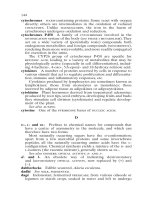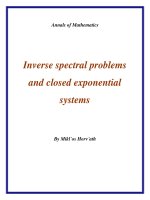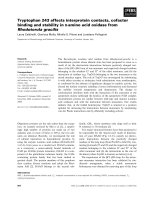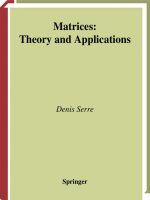63-esprit-and-closed-form2-d-angle-estimation-with-13803335928795
Bạn đang xem bản rút gọn của tài liệu. Xem và tải ngay bản đầy đủ của tài liệu tại đây (326.13 KB, 29 trang )
Martin Haardt, et. Al. “ESPRIT and Closed-Form 2-D Angle Estimation with Planar Arrays.”
2000 CRC Press LLC. <>.
ESPRITandClosed-Form2-D
AngleEstimationwithPlanar
Arrays
MartinHaardt
SiemensAG
MobileRadioNetworks
MichaelD.Zoltowski
PurdueUniversity
CherianP.Mathews
UniversityofWestFlorida
JavierRamos
PolytechnicUniversityofMadrid
63.1Introduction
Notation
63.2TheStandardESPRITAlgorithm
63.31-DUnitaryESPRIT
1-DUnitaryESPRITinElementSpace
•
1-DUnitaryESPRIT
inDFTBeamspace
63.4UCA-ESPRITforCircularRingArrays
ResultsofComputerSimulations
63.5FCA-ESPRITforFilledCircularArrays
ComputerSimulation
63.62-DUnitaryESPRIT
2-DArrayGeometry
•
2-DUnitaryESPRITinElementSpace
•
AutomaticPairingofthe2-DFrequencyEstimates
•
2-D
UnitaryESPRITinDFTBeamspace
•
SimulationResults
References
63.1 Introduction
Estimatingthedirectionsofarrival(DOAs)ofpropagatingplanewavesisarequirementinavarietyof
applicationsincludingradar,mobilecommunications,sonar,andseismology.Duetoitssimplicity
andhigh-resolutioncapability,ESPRIT(EstimationofSignalParametersviaRotationalInvariance
Techniques)[18]hasbecomeoneofthemostpopularsignalsubspace-basedDOAorspatialfrequency
estimationschemes.ESPRITisexplicitlypremisedonapointsourcemodelforthesourcesand
isrestrictedtousewitharraygeometriesthatexhibitso-calledinvariances[18].However,this
requirementisnotveryrestrictiveasmanyofthecommonarraygeometriesusedinpracticeexhibit
theseinvariances,ortheiroutputmaybetransformedtoeffecttheseinvariances.
ESPRITmaybeviewedasacomplementtotheMUSICalgorithm,theforerunnerofallsignal
subspace-basedDOAmethods,inthatitisbasedonpropertiesofthesignaleigenvectorswhereas
MUSICisbasedonpropertiesofthenoiseeigenvectors.Thischapterconcentratessolelyonthe
useofESPRITtoestimatetheDOAsofplanewavesincidentuponanantennaarray.Itshould
benoted,though,thatESPRITmaybeusedinthedualproblemofestimatingthefrequenciesof
sinusoidsembeddedinatimeseries[18].Inthisapplication,ESPRITismoregenerallyapplicable
thanMUSICasitcanhandledampedsinusoidsandprovidesestimatesofthedampingfactorsaswell
c
1999byCRCPressLLC
as the constituent frequencies. The standard ESPRIT algorithm for one-dimensional (1-D) arrays is
reviewed in Section 63.2. There are three primary steps in any ESPRIT-type algorithm:
1. Signal Subspace Estimation computation of a basis for the estimated signal subspace,
2. Solution of the Invariance Equation solution of an (in general) overdetermined system of
equations, the so-called invariance equation, derived from the basis matrix estimated in
Step 1, and
3. Spatial Frequency Estimation computation of the eigenvalues of the solution of the invari-
ance equation formed in Step 2.
Many antenna arrays used in practice have geometries that possess some form of symmetry. For
example, a linear array of equi-spaced identical antennas is symmetric about the center of the linear
aperture it occupies. In Section 63.3.1, an efficient implementation of ESPRIT is presented that
exploits the symmetry present in so-called centro-symmetric arrays to formulate the three steps
of ESPRIT in terms of real-valued computations, despite the fact that the input to the algorithm
needs to be the complex analytic signal output from each antenna. This reduces the computational
complexity significantly. A reduced dimension beamspace version of ESPRIT is developed in Sec-
tion 63.3.2. Advantages to working in beamspace include reduced computational complexity [3],
decreased sensitivity to array imperfections [1], and lower SNR resolution thresholds [11].
With a 1-D array, one can only estimate the angle of each incident plane wave relative to the array
axis. For sourcelocalization purposes, this only places the source on a cone whose axis of symmetry is
the array axis. The use of a 2-D or planar array enables one to passively estimate the 2-D arrival angles
of each emitting source. The remainder of the chapter presents ESPRIT-based techniques for use in
conjunction with circular and rectangular arrays that provide estimates of the azimuth and elevation
angle of each incident signal. As in the 1-D case, the symmetries present in these array geometries
are exploited to formulate the three primary steps of ESPRIT in terms of real-valued computations.
63.1.1 Notation
Throughout this chapter, column vectors and matrices are denoted by lower case and upper case
boldfaced letters, respectively. For any positive integer p, I
p
is the p × p identity matrix and
p
the
p × p exchange matrix with ones on its antidiagonal and zeros elsewhere,
p
=
1
1
·
1
∈ R
p×p
.
(63.1)
Pre-multiplication of a matrix by
p
will reverse the order of its rows, while post-multiplication of
a matrix by
p
reverses the order of its columns. Furthermore, the superscripts (·)
H
and (·)
T
de-
note complex conjugate transposition and transposition without complex conjugation, respectively.
Complex conjugation by itself is denoted by an overbar
(·), such that X
H
= X
T
. A diagonal matrix
with the diagonal elements φ
1
,φ
2
,...,φ
d
may be written as
= diag
{
φ
i
}
d
i=1
=
φ
1
φ
2
·
φ
d
∈ C
d×d
.
Moreover, matrices Q ∈ C
p×q
satisfying
p
Q = Q
(63.2)
willbecalledleft-real[10]. Oftenleft -realmatrices arealsocalledconjugatecentro-symmetric[24].
c
1999 by CRC Press LLC
63.2 The Standard ESPRIT Algorithm
The algorithm ESPRIT [18] must be used in conjunction with an M-element sensor array composed
of m pairs of pairwise identical, but displaced, sensors (doublets) as depicted in Fig. 63.1. If the
subarraysdonot overlap, i.e., if they donotshareanyelements, M = 2m, but ingeneral M ≤ 2m since
overlapping subarrays are allowed, cf. Fig. 63.2.Let denote the distance between the two subarrays.
Incidentonbothsubarraysare d narrowbandnoncoherent
1
planarwavefrontswithdistinctdirections
FIGURE 63.1: Planar array composed of m = 3 pairwise identical, but displaced, sensors (doublets).
of arrival (DOAs) θ
i
, 1 ≤ i ≤ d, relative to the displacement between the two subarrays.
2
Their
complex pre-envelope at an arbitrary reference point may be expressed as s
i
(t) = α
i
(t)e
j
(
2πf
c
t+β
i
(t)
)
,
where f
c
denotes the common carrier frequency of the d wavefronts. Without loss of generality,
we assume that the reference point is the array centroid. The signals are called narrowband if their
amplitudes α
i
(t) and phases β
i
(t) vary slowly with respect to the propagation time across the array τ,
i.e., if
α
i
(t − τ)≈ α
i
(t) and β
i
(t − τ)≈ β
i
(t).
(63.3)
In other words, the narrowband assumption allows the time-delay of the signals across the array τ
to be modeled as a simple phase shift of the carrier frequency, such that
s
i
(t − τ)≈ α
i
(t)e
j
(
2πf
c
(t−τ)+β
i
(t)
)
= e
−
j
2πf
c
τ
s
i
(t).
Figure 63.1 shows that the propagation delay of a plane wave signal between the two identical sensors
of a doublet equals τ
i
=
sin θ
i
c
,wherec denotes the signal propagation velocity. Due to the
narrowband assumption (63.3), this propagation delay τ
i
corresponds to the multiplication of the
complex envelope signal by the complex exponential e
j
µ
i
, referred to as the phase factor, such that
s
i
(t − τ
i
) = e
−
j
2πf
c
c
sin θ
i
s
i
(t) = e
j
µ
i
s
i
(t),
(63.4)
where the spatial frequencies µ
i
are given by µ
i
=−
2π
λ
sin θ
i
.Here,λ =
c
f
c
denotes the common
wavelength of the signals. We also assume that there is a one-to-one correspondence between the
1
This restriction can be modified later as Unitary ESPRIT can estimate the directions of arrival of two coherent wavefronts
due to an inherent forward-backward averaging effect. Two wavefronts are called coherent if their cross-correlation
coefficient has magnitude one. The directions of arrival of more than two coherent wavefronts can be estimated by using
spatial smoothing as a preprocessing step.
2
θ
k
= 0 corresponds to the direction perpendicular to .
c
1999 by CRC Press LLC
spatial frequencies −π<µ
i
<πand the range of possible DOAs. Thus, the maximum range is
achieved for ≤ λ/2. In this case, the DOAs are restricted to the interval −90
◦
<θ
i
< 90
◦
to avoid
ambiguities.
In the sequel, the d impinging signals s
i
(t), 1 ≤ i ≤ d, are combined to a column vector s(t).
Then the noise-corrupted measurements taken at the M sensors at time t obey the linear model
x(t) =
a(µ
1
) a(µ
2
) ··· a(µ
d
)
s
1
(t)
s
2
(t)
.
.
.
s
d
(t)
+ n(t) = As(t) + n(t) ∈ C
M
,
(63.5)
where the columns of the array steering matrix A ∈ C
M×d
, the array response or array steering
vectors a(µ
i
), are functions of the unknown spatial frequencies µ
i
, 1 ≤ i ≤ d. For example, for a
uniform linear array (ULA) of M identical omnidirectional antennas,
a(µ
i
) = e
−
j
M−1
2
µ
i
1 e
j
µ
i
e
j
2µ
i
··· e
j
(M−1)µ
i
T
, 1 ≤ i ≤ d.
Moreover, the additive noise vector n(t) is taken from a zero-mean, spatially uncorrelated random
process with variance σ
2
N
, which is also uncorrelated with the signals. Since every row of A corre-
sponds to an element of the sensor array, a particular subarray configuration can be described by two
selection matrices, each choosing m elements of x(t) ∈ C
M
,wherem, d ≤ m<M, is the number
of elements in each subarray. Figure 63.2, for example, displays the appropriate subarray choices for
three centro-symmetric arrays of M = 6 identical sensors.
FIGURE 63.2: Three centro-symmetric line arrays of M = 6 identical sensors and the corresponding
subarrays required for ESPRIT-type algorithms.
In case of a ULA with maximum overlap, cf. Figure 63.2 (a), J
1
picks the first m = M − 1 rows of A,
while J
2
selects the last m = M −1 rows of the array steering matrix. In this case, the corresponding
selection matrices are given by
J
1
=
100··· 00
010··· 00
.
.
.
.
.
.
.
.
. ·
.
.
.
.
.
.
000··· 10
∈ R
m×M
and J
2
=
010··· 00
001··· 00
.
.
.
.
.
.
.
.
. ·
.
.
.
.
.
.
000··· 01
∈ R
m×M
.
Notice that J
1
and J
2
are centro-symmetric with respect to one another, i.e., they obey J
2
=
m
J
1
M
. This property holds for all centro-symmetric arrays and plays a key role in the derivation
of Unitary ESPRIT [7]. Since we have two identical, but physically displaced subarrays, Eq. (63.4)
indicates that an array steering vector of the second subarray J
2
a(µ
i
) is just a scaled version of the
corresponding array steering vector of the first subarray J
1
a(µ
i
), namely
J
1
a(µ
i
)e
j
µ
i
= J
2
a(µ
i
), 1 ≤ i ≤ d.
(63.6)
c
1999 by CRC Press LLC
This shift invariance property of all d array steering vectors a(µ
i
) may be expressed in compact form
as
J
1
A = J
2
A, where = diag
e
j
µ
i
d
i=1
(63.7)
is the unitary diagonal d × d matrix of the phase factors. All ESPRIT-type algorithms are based on
this invariance property of the array steering matrix A,whereA is assumed to have full column rank
d.
Let X denote an M × N complex data matrix composed of N snapshots x(t
n
), 1 ≤ n ≤ N,
X =
x(t
1
) x(t
2
) ··· x(t
N
)
(63.8)
= A
s(t
1
) s(t
2
) ··· s(t
N
)
+
n(t
1
) n(t
2
) ··· n(t
N
)
= A · S + N ∈ C
M×N
.
The starting point is a singular value decomposition (SVD) of the noise-corrupted data matrix X
(direct data approach). Assume that U
s
∈ C
M×d
contains the d left singular vectors corresponding
to the d largest singular values of X. Alternatively, U
s
can be obtained via an eigendecomposition
of the (scaled) sample covariance matrix XX
H
(covariance approach). Then, U
s
∈ C
M×d
contains
the d eigenvectors corresponding to the d largest eigenvalues of XX
H
.
Asymptotically, i.e., as the number of snapshots N becomes infinitely large, the range space of U
s
is the d-dimensional range space of the array steering matrix A referredtoasthesignal subspace.
Therefore, there exists a nonsingular d × d matrix T such that A ≈ U
s
T . Let us express the
shift-invariance property (63.7) in terms of the matrix U
s
that spans the estimated signal subspace,
J
1
U
s
T≈ J
2
U
s
T ⇐⇒ J
1
U
s
≈ J
2
U
s
, where = TT
−1
is a nonsingular d×d matrix. Since in Eq. (63.7) is diagonal, TT
−1
is in the form of an eigenvalue
decomposition. This implies that e
j
µ
i
, 1 ≤ i ≤ d, are the eigenvalues of . These observations form
the basis for the subsequent steps of the algorithm. By applying the two selection matrices to the
signal subspace matrix, the following (in general) overdetermined set of equations is formed,
J
1
U
s
≈ J
2
U
s
∈ C
m×d
.
(63.9)
This set of equations, the so-called invariance equation, is usually solved in the least squares (LS) or
total least squares (TLS) sense. Notice, however, that Eq. (63.9) is highly structured if overlapping
subarray configurations are used. Structured least squares (SLS) is a new algorithm to solve the
invariance equation by preserving its structure [8]. Formally, SLS was derived as a linearized iterative
solution of a nonlinear optimization problem. If SLS is initialized with the LS solution of the
invariance equation, only one “iteration”, i.e., the solution of one linear system of equations, is
required to achieve a significant improvement of the estimation accuracy [8].
Then an eigendecomposition of the resulting solution ∈ C
d×d
may be expressed as
= TT
−1
with = diag
{
φ
i
}
d
i=1
.
(63.10)
The eigenvalues φ
i
, i.e., the diagonal elements of , represent estimates of the phase factors e
j
µ
i
.
Notice that the φ
i
are not guaranteed to be on the unit circle. Notwithstanding, estimates of the
spatial frequencies µ
i
and the corresponding DOAs θ
i
are obtained via the relationships,
µ
i
= arg
(
φ
i
)
and θ
i
=−
λ
2π
arcsin
(
µ
i
)
, 1 ≤ i ≤ d.
(63.11)
To end this section, a brief summary of the standard ESPRIT algorithm is given in Table 63.1.
c
1999 by CRC Press LLC
TABLE 63.1 Summary of the Standard ESPRIT Algorithm
1. Signal Subspace Estimation: Compute
U
s
∈
C
M×d
as the
d
dominant left singular vectors of
X ∈
C
M×N
.
2. Solution of the Invariance Equation: Solve
J
1
U
s
C
m×d
≈ J
2
U
s
C
m×d
by means of LS, TLS, or SLS.
3. Spatial Frequency Estimation: Calculate the eigenvalues of the resulting complex-valued solution
= TT
−1
∈
C
d×d
with
=
diag
φ
i
d
i=1
• µ
i
= arg
φ
i
, 1 ≤ i ≤ d
63.3 1-D Unitary ESPRIT
In contrast to the standard ESPRIT algorithm, Unitary ESPRIT is efficiently formulated in terms of
real-valued computations throughout [7]. It is applicable to centro-symmetric array configurations
that possess the discussed invariance structure, cf. Figs. 63.1 and 63.2. A sensor array is called centro-
symmetric [23] if its element locations are symmetric with respect to the centroid. If the sensor
elements have identical radiation characteristics, the array steering matrix of a centro-symmetric
array satisfies
M
A = A,
(63.12)
since the array centroid is chosen as the phase reference.
63.3.1 1-D Unitary ESPRIT in Element Space
Before presenting an efficient element space implementation of Unitary ESPRIT, let us define the
sparse unitary matrices
Q
2n
=
1
√
2
I
n
j
I
n
n
−
j
n
and Q
2n+1
=
1
√
2
I
n
0
j
I
n
0
T
√
2 0
T
n
0 −
j
n
.
(63.13)
They are left -real matrices of even and odd order, respectively.
Since Unitary ESPRIT involves forward-backward averaging, it can efficiently be formulated in
terms of real-valued computations throughout, due to a one-to-one mapping between centro-
Hermitian and real matrices [10]. The forward-backward averaged sample covariance matrix is
centro-Hermitian and can, therefore, be transformed into a real-valued matrix of the same size,
cf. [12], [15], and [7]. A real-valued square-root factor of this transformed sample covariance matrix
is given by
T (X) = Q
H
M
X
M
X
N
Q
2N
∈ R
M×2N
,
(63.14)
whereQ
M
and Q
2N
weredefinedinEq.(63.13).
3
If M iseven, anefficientcomputationof T (X)from
the complex-valued data matrix X only requires M × 2N real additions and no multiplication [7].
Instead of computing a complex-valued SVD as in the standard ESPRIT case, the signal subspace
estimate is obtained via a real-valued SVD of T (X) (direct data approach). Let E
s
∈ R
M×d
contain
the d left singular vectors corresponding to the d largest singular values of T (X).
4
Then the columns
3
The results of this chapter also hold if Q
M
and Q
2N
denote arbitrary left -real matrices that are also unitary.
4
Alternatively, E
s
can be obtained through a real-valued eigendecomposition of T (X)T (X)
H
(covariance approach).
c
1999 by CRC Press LLC
of
U
s
= Q
M
E
s
(63.15)
span the estimated signal subspace, and spatial frequency estimates could be obtained fromthe eigen-
values of the complex-valued matrix that solves Eq. (63.9). These complex-valued computations,
however, are not required because the transformed array steering matrix
D = Q
H
M
A =
d(µ
1
) d(µ
2
) ··· d(µ
d
)
∈ R
M×d
(63.16)
satisfies the following shift invariance property
K
1
D= K
2
D, where = diag
tan
µ
i
2
d
i=1
(63.17)
and the transformed selection matrices K
1
and K
2
are given by
K
1
= 2 · Re{Q
H
m
J
2
Q
M
} and K
2
= 2 · Im{Q
H
m
J
2
Q
M
}.
(63.18)
Here, Re
{
·
}
and Im
{
·
}
denote the real and the imaginary part, respectively. Notice that Eq. (63.17)
is similar to Eq. (63.7) except for the fact that all matrices in Eq. (63.17) are real-valued.
Let us take a closer look at the transformed selection matrices defined in Eq. (63.18). If J
2
is
sparse, K
1
and K
2
are also sparse. This is illustrated by the following example. For the ULA with
M = 6 sensors and maximum overlap sketched in Fig. 63.2 (a), J
2
is given by
J
2
=
010000
001000
000100
000010
000001
∈ R
5×6
.
According to Eq. (63.18), straightforward calculations yield the transformed selection matrices
K
1
=
11 0000
01 1000
00
√
2000
00 0110
00 0011
and K
2
=
000−11 0
0000−11
00000−
√
2
1 −1000 0
01−100 0
.
In this case, applying K
1
or K
2
to E
s
only requires (m−1)d real additions and d real multiplications.
Asymptotically, the real-valued matrices E
s
and D span the same d-dimensional subspace, i.e.,
there is a nonsingular matrix T ∈ R
d×d
such that D ≈ E
s
T . Substituting this into Eq. (63.17)
yields the real-valued invariance equation
K
1
E
s
ϒ ≈ K
2
E
s
∈ R
m×d
, where ϒ = TT
−1
.
(63.19)
Thus, the eigenvalues of the solution ϒ ∈ R
d×d
to the matrix equation above are
ω
i
= tan
µ
i
2
=
1
j
e
j
µ
i
− 1
e
j
µ
i
+ 1
, 1 ≤ i ≤ d.
(63.20)
This reveals a spatial frequency warping identical to the temporal frequency warping incurred in
designing a digital filter from an analog filter via the bilinear transformation. Consider =
λ
2
so that µ
i
=−
2π
λ
sin θ
i
=−π sin θ
i
. In this case, there is a one-to-one mapping between
c
1999 by CRC Press LLC
−1 < sin θ
i
< 1, corresponding to the range of possible values for the DOAs −90
◦
<θ
i
< 90
◦
, and
−∞ <ω
i
< ∞.
Note that the fact that the eigenvalues of a real matrix have to either be real-valued or occur in
complexconjugate pairs gives rise to an ad-hoc reliability test. That is, if the final step of the algorithm
yields a complex conjugate pair of eigenvalues, then either the SNR is too low, not enough snapshots
have been averaged, or two corresponding signal arrivals have not been resolved. In the latter case,
taking the tangent inverse of the real part of the eigenvalues can sometimes provide a rough estimate
of the direction of arrival of the two closely spaced signals. In general, though, if the algorithm yields
one or more complex-conjugate pairs of eigenvalues in the final stage, the estimates should be viewed
as unreliable.
The element space implementation of 1-D Unitary ESPRIT is summarized in Table 63.2.
TABLE 63.2 Summary of 1-D Unitary ESPRIT in Element Space
1. Signal Subspace Estimation: Compute
E
s
∈
R
M×d
as the
d
dominant left singular vectors of
T
(X) ∈
R
M×2N
.
2. Solution of the Invariance Equation: Then solve
K
1
E
s
R
m×d
ϒ ≈ K
2
E
s
R
m×d
by means of LS, TLS, or SLS.
3. Spatial Frequency Estimation: Calculate the eigenvalues of the resulting real-valued solution
ϒ = TT
−1
∈
R
d×d
with
=
diag
ω
i
d
i=1
• µ
i
= 2 arctan
ω
i
, 1 ≤ i ≤ d
63.3.2 1-D Unitary ESPRIT in DFT Beamspace
Reduced dimension processing in beamspace, yielding reduced computational complexity, is an
option when one has a priori information on the general angular locations of the incident signals,
as in a radar application, for example. In the case of a uniform linear array (ULA), transformation
from element space to DFT beamspace may be effected by pre-multiplying the data by those rows of
the DFT matrix that form beams encompassing the sector of interest. (Each row of the DFT matrix
forms a beam pointed to a different angle.) If there is no a priori information, one may examine the
DFT spectrum and apply Unitary ESPRIT in DFT beamspace to a small set of DFT values around
each spectral peak above a particular threshold. In a more general setting, Unitary ESPRIT in DFT
beamspace can simply be applied via parallel processing to each of a number of sets of successive DFT
values corresponding to overlapping sectors.
Note, though, that in the development to follow, we will initially employ all M DFT beams for the
sake of notational simplicity. Without loss of generality, we consider an omnidirectional ULA. Let
W
H
M
∈ C
M×M
be the scaled M-point DFT matrix with its M rows given by
w
H
k
= e
j
M−1
2
k
2π
M
1 e
−
j
k
2π
M
e
−
j
2k
2π
M
··· e
−
j
(M−1)k
2π
M
, 0 ≤ k ≤ (M − 1).
(63.21)
Notice that W
M
is left -real or column conjugate symmetric, i.e.,
M
W
M
= W
M
. Thus, as
pointed out for D in Eq. (63.16), the transformed steering matrix of the ULA
B = W
H
M
A =
b(µ
1
) b(µ
2
) ··· b(µ
d
)
∈ R
M×d
(63.22)
c
1999 by CRC Press LLC
is real-valued. It has been shown in [24] that B satisfies a shift invariance property which is similar
to Eq. (63.17), namely
1
B=
2
B, where = diag
tan
µ
i
2
d
i=1
.
(63.23)
Here, the selection matrices
1
and
2
of size M × M are defined as
1
=
1 cos
π
M
00··· 00
0 cos
π
M
cos
2π
M
0 ··· 00
0 0 cos
2π
M
cos
3π
M
··· 00
.
.
.
.
.
.
.
.
.
.
.
. ·
.
.
.
.
.
.
00 0 0··· cos
(M − 2)
π
M
cos
(M − 1)
π
M
(−1)
M
00 0··· 0 cos
(M − 1)
π
M
(63.24)
2
=
0 sin
π
M
00··· 00
0 sin
π
M
sin
2π
M
0 ··· 00
0 0 sin
2π
M
sin
3π
M
··· 00
.
.
.
.
.
.
.
.
.
.
.
. ·
.
.
.
.
.
.
00 0 0··· sin
(M − 2)
π
M
sin
(M − 1)
π
M
00 0 0··· 0 sin
(M − 1)
π
M
.
(63.25)
As an alternative to Eq. (63.14), another real-valued square-root factor of the transformed sample
covariance matrix is given by
Re
{
Y
}
Im
{
Y
}
∈ R
M×2N
, where Y = W
H
M
X ∈ C
M×N
.
(63.26)
The matrix Y can efficiently be computed via an FFT, which exploits the Vandermonde form of
the rows of the DFT matrix, followed by an appropriate scaling, cf. Eq. (63.21). Let the columns
of E
s
∈ R
M×d
contain the d left singular vectors corresponding to the d largest singular values
of Eq. (63.26). Asymptotically, the real-valued matrices E
s
and B span the same d-dimensional
subspace, i.e., there is a nonsingular matrix T ∈ R
d×d
, such that B ≈ E
s
T . Substituting this into
Eq. (63.23), yields the real-valued invariance equation
1
E
s
ϒ ≈
2
E
s
∈ R
M×d
, where ϒ = TT
−1
.
(63.27)
Thus, the eigenvalues of the solution ϒ ∈ R
d×d
to the matrix equation above are also given by
Eq. (63.20).
It is a crucial observation that one row of the matrix equation (63.23) relates two successive compo-
nentsofthetransformed arraysteeringvectors b(µ
i
), cf. (63.24) and (63.25). This insight enablesusto
apply only B M successive rows of W
H
M
(instead of all M rows) to the data matrix X in Eq. (63.26).
To stress the reduced number of rows, we call the resulting beamforming matrix W
H
B
∈ C
B×M
.The
number of its rows, B, depends on the width of the sector of interest and may be substantially less
than the number of sensors M. Thereby, the SVD of Eq. (63.26) and, therefore, also E
s
∈ R
B×d
and the invariance equation (63.27) will have a reduced dimensionality. Employing the appropri-
ate subblocks of
1
and
2
as selection matrices, the algorithm is the same as the one described
previously except for its reduced dimensionality. In the sequel, the resulting selection matrices of
size (B −1)× B will be called
(B)
1
and
(B)
2
. The whole algorithm that operates in a B-dimensional
DFT beamspace is summarized in Table 63.3.
Consider, for example, a ULA of M = 8 sensors. The structure of the corresponding selection
matrices
1
and
2
is sketched in Fig. 63.3. Here, the symbol × denotes entries of both selection
matrices that might be nonzero, cf. (63.24) and (63.25). If one employed rows 4, 5, and 6 of W
H
8
to
form B = 3 beams in estimating the DOAs of two closely spaced signal arrivals, as in the low-angle
c
1999 by CRC Press LLC
TABLE 63.3 Summary of 1-D Unitary ESPRIT in DFT Beamspace
0. Transformation to Beamspace:
Y = W
H
B
X ∈
C
B×N
1. Signal Subspace Estimation: Compute
E
s
∈
R
B×d
as the
d
dominant left singular vectors of
Re
{
Y
}
Im
{
Y
}
∈
R
B×2N
.
2. Solution of the Invariance Equation: Solve
(B)
1
E
s
R
(B−1)×d
ϒ ≈
(B)
2
E
s
R
(B−1)×d
by means of LS, TLS, or SLS.
3. Spatial Frequency Estimation: Calculate the eigenvalues of the resulting real-valued solution
ϒ = TT
−1
∈
R
d×d
with
=
diag
ω
i
d
i=1
• µ
i
= 2 arctan
ω
i
, 1 ≤ i ≤ d
FIGURE 63.3: Structure of the selection matrices
1
and
2
for a ULA of M = 8 sensors. The
symbol × denotes entries of both selection matrices that might be nonzero. The shaded areas
illustrate how to choose the appropriate subblocks of the selection matrices for reduced dimension
processing, i.e., how to form
(B)
1
and
(B)
2
,ifonlyB = 3 successive rows of W
H
8
are applied to the
data matrix X. Here, the following two examples are used: (a) rows 4, 5, and 6. (b) rows 8, 1,
and 2.
radar tracking scheme described by Zoltowski and Lee [26], the corresponding 2× 3 subblock of the
selection matrices
1
and
2
is shaded in Fig. 63.3 (a).
5
Notice that the first and the last (Mth) row
of W
H
M
steer beams that are also physically adjacent to one another (the wrap-around property of the
DFT). If, for example, one employed rows 8, 1, and 2 of W
H
8
to form B = 3 beams in estimating the
DOAs of two closely spaced signal arrivals, the corresponding subblocks of the selection matrices
1
and
2
are shaded in Fig. 63.3 (b).
6
5
Here, the first row of
(3)
1
and
(3)
2
combines beams 4 and 5, while the second row of
(3)
1
and
(3)
2
combines beams
5 and 6.
6
Here, the first row of
(3)
1
and
(3)
2
combines beams 1 and 2, while the second row of
(3)
1
and
(3)
2
combines beams
1 and 8.
c
1999 by CRC Press LLC









